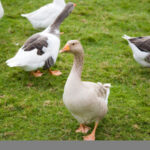Fall in the Midwest begins as Daylight Savings Time returns to standard time. Darkness settles in an hour earlier as a cold wind from the north begins spreading across the land. Farmers rush to finish the harvest, some just before the first snow dusts the still warm ground of summer. A hard freeze is just around the corner, too soon for most. Memories of the warm summer sun are quickly forgotten as a brisk Canadian wind closes windows and doors. Brilliant leaves of reds, yellows and orange sail to the ground as winter’s chill reminds us to search the closets for warm coats, gloves and hats. The time has come to look toward the sky for the flight of the Canadian Geese.
Geese families gather to form a flock in late August or early September and begin their migration south as the approaching winter begins to freeze the ground and their food source becomes scarce. Some come from as far north as Alaska and the upper most regions in Canada. They will winter in southern Canada, the United States and Mexico.
Honking from a passing flock will definitely draw your eyes upward. I live near a small pond on their migration route in the Midwest. As they circle in preparation to land, they are at times only twenty or so yards above our heads. Close enough to look into their black eyes and send my dogs into a frenzy.
The Canadian Goose is only one of a few species where the male and female look alike. The white cheeks, black head and neck are as familiar as their V-shape formation in the sky. Although, a flock will fly in a straight line at times. Anyway, as straight as they can.
Canadian Geese fly in a V-shape formation to conserve energy, scientists believe. It’s called the “drafting effect”. The lead bird splits the air current which makes it easier for the rest to move efficiently through the air. When the lead bird tires, it moves to the back and the next one in line takes over. This formation also allows the birds the ability to keep an eye on each other and communicate landing locations.
They are built for long distance travel, covering 650 to 1,000 miles a day at speeds up to 60 mph. They can fly day or night at altitudes up to 8,000 feet. Some flocks will migrate a distance of 2,500 miles.
Scientists believe geese follow coastlines, rivers and mountain ranges in what is known as flyways or migration corridors. These corridors are known as the Atlantic, Mississippi, Central and Pacific routes.
Canadian Geese mate for life and are very loyal to each other. If one has to land due to an injury or tiredness, the mate will follow to protect the injured or tired bird. There both will remain until the injured or tired mate recovers. Both parents care for and protect their young. They can live up to 30 years in the wild and longer if domesticated.
These birds are very large and aggressive. Hunters are their top predator. Animal predators include: dogs, raccoons, weasels, foxes and owls. Other birds simply fly away to escape danger on the ground, but the Canadian Goose has an attitude and can be stubborn. They are more likely to stand their ground and fight off an intruder. This tactic isn’t always successful. However, because they are flock-oriented, help will arrive to discourage an attack from a natural predator.
A goose diet includes grasses, marsh grass, berries and seeds. They will eat pond plants, tubers, roots and algae. A sharp eyed flock of geese will enjoy leftovers in a farmer’s harvested field such as corn, barley, oats, wheat, rye, alfalfa and clover.
Now days, geese can be found wintering in the upper Midwest. More people willing to feed the geese entice them to endure a colder north for free food. If you are one of the feeders, please stay away from junk foods like chips and cookies. Instead, toss small pieces of bread, spinach, lettuce, peas, corn or grains.
As winter snows begin to melt and a warm breath from the south begins to drift north, the geese will begin their trip back into Canada and Alaska. Those who fly farther north will begin in late January or early February. They will follow the melting snow line and stop often to rest and eat. Nesting and laying eggs start as soon as they reach their nesting grounds.
Sources:
Lisa Shea, Where Do Canada Geese Migrate, Bella Online-The Voice of Women, bellaonline.com
Canada Goose, Saskschools.com
Chipper Woods Bird Observatory, Migrating Geese, wbu.com





